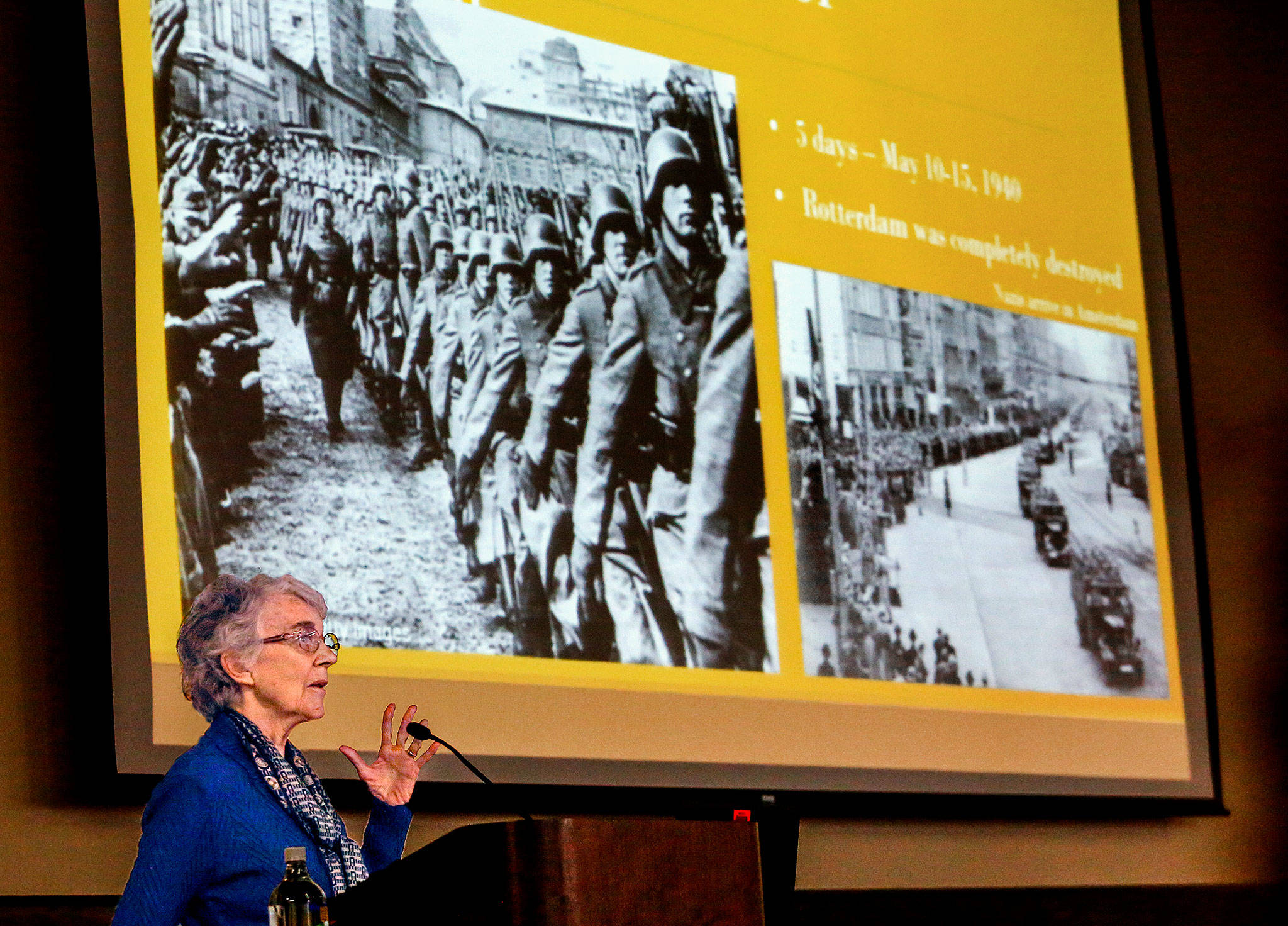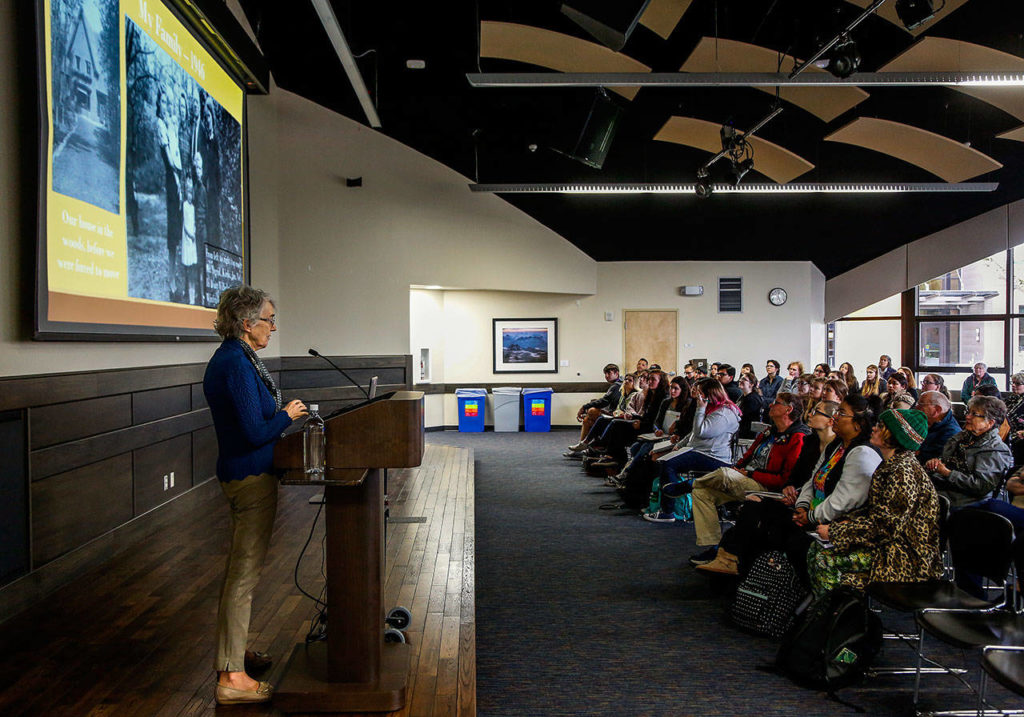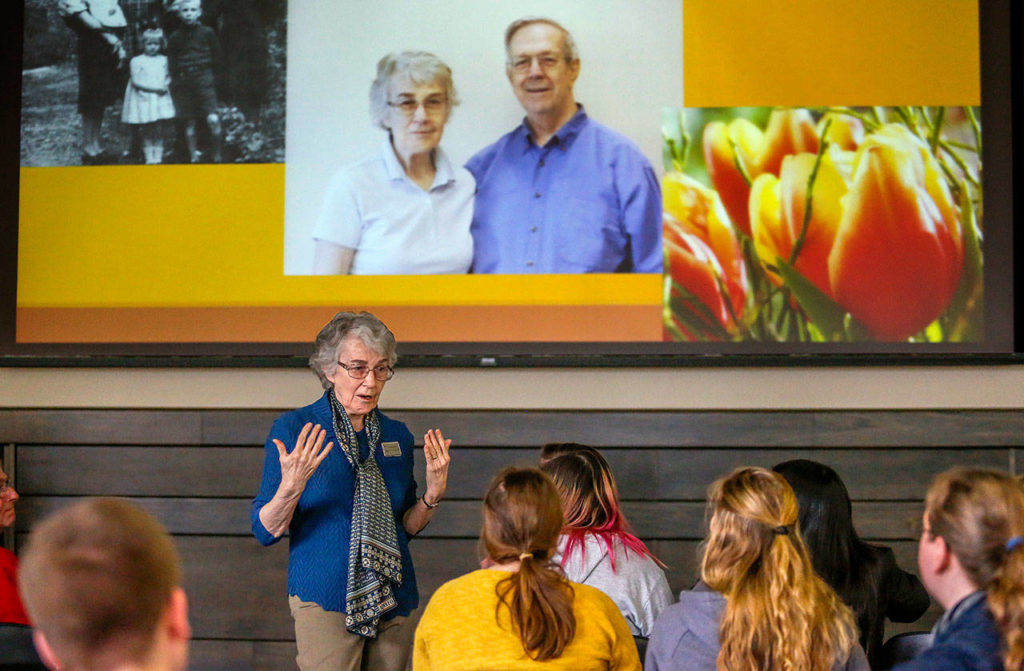Ingrid Kanis Steppic is a daughter of the Dutch resistance. She was born in 1943, three years after the Nazis invaded her homeland. Throughout the occupation, her parents sheltered and helped Jewish “hiders.”
“It was very dangerous,” Steppic told students Wednesday at Everett Community College.
She was too young to have clear memories of life in The Netherlands during World War II. What she can share are the heroic and haunting experiences of her parents, Jan and Nel Kanis, during German occupation.
Her father Jan Kanis and an older sister were both imprisoned for their involvement with the Dutch underground. Her family wasn’t Jewish, but throughout the Nazis’ five-year hold on Holland they provided shelter, food and other help — assisting some 40 Jews in all.
Steppic, who is 74 and lives in Seattle, was the first of four speakers scheduled as part of EvCC’s Humanities 150D class, “Surviving the Holocaust.” She’s part of the Seattle-based Holocaust Center for Humanity’s speakers bureau. The annual Holocaust series, now in its 19th year, is open to the public.
For nearly two decades, the class has been taught by EvCC instructor Joyce Walker. She began Wednesday’s program with a mention of previous speakers who have died. They include Holocaust survivors Thomas Blatt, Fred Taucher and Robert Herschkowitz and Army veteran Leo Hymas, who was among the liberating forces. Their loss points to the importance of second-generation survivors as keepers of Holocaust memories.
On Thursday, international Holocaust Remembrance Day or Yom Hashoah in Hebrew, The New York Times published a survey showing that many Americans lack knowledge of the Holocaust. According to the survey of 1,350 adults, 41 percent of them and 66 percent of millennials cannot say what Auschwitz was — the extermination camp in Poland. And 31 percent, or 41 percent of millennials, believe 2 million or fewer Jews — rather than 6 million — were killed.
A day before the Germans invaded Holland on May 10, 1940, the Kanis family had moved to the city of Amersfoort, where Jan Kanis managed the post office. The Dutch battled the Germans for just five days. Liberation wouldn’t come for five years, on May 5, 1945.
From his job, where he saw returned mail and death notices, Kanis knew early that Jews weren’t just being rounded up — they were being killed. He warned Jews not to register, and not to show up at the train station as ordered.
“These were not nameless people — they lived and worked in our town,” Steppic said.
The Kanis family, with five children, sheltered two Jewish couples. One couple, the Schnells, were later forced to dig their own graves before being shot to death by the Nazis, Steppic said. “All our other hiders did survive,” she said.
Her sister Ali was imprisoned at 17, Steppic said, for bringing money to striking rail workers. The Netherlands’ Queen Wilhelmina had fled to England, but sent word asking that railroads go on strike, a tactic meant to hinder German progress.
In 1944, Jan Kanis was sent to the Dachau concentration camp in Germany for taking part in a raid to get ration stamps. He survived, but was sickly when he came out of the camp in 1945.
His family had been feeding not only themselves, but those they were hiding. In what was called the “hongerwinter” of 1944-45, thousands of Dutch people starved to death. Steppic said many ate tulip bulbs.
Steppic showed a marker placed at Yad Vashem, the Holocaust memorial in Israel. In 1970, her parents were recognized at the memorial as the “Righteous Among the Nations.”
She still has sisters in The Netherlands. She married an American soldier, Richard Steppic, and moved to the United States in the 1960s.
Through email, she has been in touch with a New Jersey woman, Maud Dahme, who, during the war, was helped to hide by Jan Kanis. On the other side of the country, Dahme has shared her story of being a “hidden child.”
There was another Everett event in observance of Holocaust Remembrance Day. At Temple Beth Or, a Reform Jewish synagogue, six candles were lit in memory of the 6 million who died, and the Mourner’s Kaddish prayer was recited Wednesday evening.
That somber rite was followed by an educational program, “no. NOT EVER,” presented by the Seattle group If You Don’t They Will.
Temple Beth Or’s social action committee organized the gathering. It included discussions of white nationalist groups and tactics for countering racism. Participants included people from other faith communities and local organizations.
In small groups, people talked about possible responses to several scenerios: Students starting a “white pride” group at school; posters appearing that attack tribal fishing rights; or public art being vandalized with swastikas.
Pam Lonergan is a Temple Beth Or member from Monroe. After discussing anti-Semitism and other brands of hate in today’s world, she was asked about appropriate ways to remember the Holocaust. “This is it,” she said.
Julie Muhlstein: 425-339-3460; jmuhlstein@heraldnet.com.
Holocaust talks
Holocaust survivors and their family members will share survival stories as part of Everett Community College’s Humanities 150D class “Surviving the Holocaust.” Talks are free and open to the public. All are 12:20-1:20 p.m. on the EvCC campus, 2000 Tower St. Programs supported by the Holocaust Center for Humanity and the EvCC Foundation.
April 25: Henry Friedman was a teen in Poland when his family hid from the Nazis for 18 months. Henry M. Jackson Conference Center, Wilderness Room
May 9: Ron Friedman, son of Holocuast survivor Herbert Friedman, speaks about his father’s escape from Nazi-controlled Vienna at 13 as part of the Kindertransport (children’s trains) England. Baker Hall, Room 120.
May 23: Peter Metzelaar and his mother were hidden, through the Dutch resistance, on a farm, in a cave and in a home in The Hague. Henry M. Jackson Conference Center, Wilderness Room
Talk to us
> Give us your news tips.
> Send us a letter to the editor.
> More Herald contact information.




























